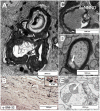Stepchild or Prodigy? Neuroprotection in Multiple Sclerosis (MS) Research
- PMID: 26140377
- PMCID: PMC4519875
- DOI: 10.3390/ijms160714850
Stepchild or Prodigy? Neuroprotection in Multiple Sclerosis (MS) Research
Abstract
Multiple sclerosis (MS) is an autoimmune disorder of the central nervous system (CNS) and characterized by the infiltration of immune cells, demyelination and axonal loss. Loss of axons and nerve fiber pathology are widely accepted as correlates of neurological disability. Hence, it is surprising that the development of neuroprotective therapies has been neglected for a long time. A reason for this could be the diversity of the underlying mechanisms, complex changes in nerve fiber pathology and the absence of biomarkers and tools to quantify neuroregenerative processes. Present therapeutic strategies are aimed at modulating or suppressing the immune response, but do not primarily attenuate axonal pathology. Yet, target-oriented neuroprotective strategies are essential for the treatment of MS, especially as severe damage of nerve fibers mostly occurs in the course of disease progression and cannot be impeded by immune modulatory drugs. This review shall depict the need for neuroprotective strategies and elucidate difficulties and opportunities.
Keywords: axonal damage; degeneration; multiple sclerosis; neuroprotection; regeneration.
Figures




Similar articles
-
Neuronal injury in chronic CNS inflammation.Best Pract Res Clin Anaesthesiol. 2010 Dec;24(4):551-62. doi: 10.1016/j.bpa.2010.11.001. Epub 2010 Nov 29. Best Pract Res Clin Anaesthesiol. 2010. PMID: 21619866 Review.
-
Neuroprotection in multiple sclerosis: a therapeutic challenge for the next decade.Pharmacol Ther. 2010 Apr;126(1):82-93. doi: 10.1016/j.pharmthera.2010.01.006. Epub 2010 Feb 1. Pharmacol Ther. 2010. PMID: 20122960 Review.
-
Multiple sclerosis - remyelination failure as a cause of disease progression.Histol Histopathol. 2012 Mar;27(3):277-87. doi: 10.14670/HH-27.277. Histol Histopathol. 2012. PMID: 22237705 Review.
-
[Neuroprotection in the treatment of multiple sclerosis].Nervenarzt. 2011 Aug;82(8):973-7. doi: 10.1007/s00115-011-3262-2. Nervenarzt. 2011. PMID: 21761185 Review. German.
-
Neuroprotection in multiple sclerosis: a therapeutic approach.CNS Drugs. 2013 Oct;27(10):799-815. doi: 10.1007/s40263-013-0093-7. CNS Drugs. 2013. PMID: 23955320 Review.
Cited by
-
5-HMF attenuates inflammation and demyelination in experimental autoimmune encephalomyelitis mice by inhibiting the MIF-CD74 interaction.Acta Biochim Biophys Sin (Shanghai). 2023 Jul 10;55(8):1222-1233. doi: 10.3724/abbs.2023105. Acta Biochim Biophys Sin (Shanghai). 2023. PMID: 37431183 Free PMC article.
-
Does Vitamin C Influence Neurodegenerative Diseases and Psychiatric Disorders?Nutrients. 2017 Jun 27;9(7):659. doi: 10.3390/nu9070659. Nutrients. 2017. PMID: 28654017 Free PMC article. Review.
-
Focus on the Role of the NLRP3 Inflammasome in Multiple Sclerosis: Pathogenesis, Diagnosis, and Therapeutics.Front Mol Neurosci. 2022 May 25;15:894298. doi: 10.3389/fnmol.2022.894298. eCollection 2022. Front Mol Neurosci. 2022. PMID: 35694441 Free PMC article. Review.
-
Disease Modification in Multiple Sclerosis by Flupirtine-Results of a Randomized Placebo Controlled Phase II Trial.Front Neurol. 2018 Oct 9;9:842. doi: 10.3389/fneur.2018.00842. eCollection 2018. Front Neurol. 2018. PMID: 30356868 Free PMC article.
-
Nimodipine fosters remyelination in a mouse model of multiple sclerosis and induces microglia-specific apoptosis.Proc Natl Acad Sci U S A. 2017 Apr 18;114(16):E3295-E3304. doi: 10.1073/pnas.1620052114. Epub 2017 Apr 5. Proc Natl Acad Sci U S A. 2017. PMID: 28381594 Free PMC article.
References
Publication types
MeSH terms
Substances
LinkOut - more resources
Full Text Sources
Other Literature Sources
Medical

